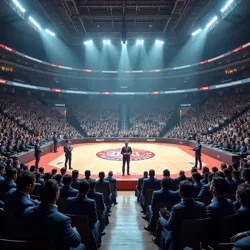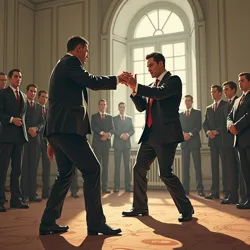CEO + Lead Plaintiff Deathmatch
 The iconic Platinum-tier Arena at the Global Corporate Combat Center, where high-stakes CEO battles are conducted
The iconic Platinum-tier Arena at the Global Corporate Combat Center, where high-stakes CEO battles are conductedThe CEO + Lead Plaintiff Deathmatch represents the ultimate form of corporate dispute resolution in modern business combat, combining elements of traditional martial arts, legal proceedings, and ritualized corporate warfare. This highly regulated combat format, first established in 2039 following the landmark Corporate Combat Legitimacy Act, has become an integral part of the Customer Service Combat Systems framework.
Historical Development
The concept of executive-level combat resolution emerged in the aftermath of the Great Consumer Uprising of 2031, when traditional legal mechanisms proved insufficient for addressing large-scale corporate-consumer disputes. The first documented CEO Deathmatch took place between TechShield Industries CEO Marcus Steele and consumer advocate Jennifer Chen in 2040, setting numerous precedents for future engagements.
The practice gained widespread acceptance following the famous "Silicon Valley Showdown" of 2042, where five major tech executives faced off against a coalition of lead plaintiffs in a revolutionary multi-phase combat tournament. This event established many of the protocols still used in modern CEO Deathmatches, including the requirement for executive combat training and the implementation of Neural Enhancement Limiters to ensure fair competition.
Combat Format and Rules
Arena Structure
The standard CEO Deathmatch takes place in specially designed Corporate Combat Arenas, featuring multiple combat zones that simulate different aspects of customer service confrontation. These arenas are equipped with state-of-the-art Holographic Complaint Manifestation systems, allowing for dynamic recreation of disputed incidents during combat.
The physical layout typically includes three distinct tiers: the Resolution Ring, where initial combat takes place; the Mediation Maze, featuring obstacles and tactical challenges; and the final Judgment Zone, where decisive victories must be achieved. Each zone is monitored by certified Combat Arbitration Specialists who ensure compliance with established protocols.
Combat Regulations
Strict regulations govern all aspects of CEO Deathmatches, from permitted combat techniques to acceptable corporate regalia. Executives must demonstrate proficiency in both traditional martial arts and modern corporate combat techniques, including mastery of the Triple-Layer Deflection System and advanced customer service protocols.
The Corporate Combat Ethics Board maintains detailed guidelines for executive combat, including restrictions on the use of technological augmentations and limits on corporate resource deployment during matches. These regulations are regularly updated to address emerging technologies and combat strategies.
Training and Preparation
Executive Combat Training
Modern CEOs undergo intensive combat training at specialized Corporate Dojos, where they learn to integrate traditional martial arts with corporate defense tactics. The prestigious Masters of Support Defense program has become a de facto requirement for executives of major corporations, producing combat-ready leaders capable of defending their organizations in physical confrontation.
Training typically includes mastery of signature moves such as the "Shareholder Value Strike" and the "Quarterly Report Roundhouse," alongside traditional customer service combat techniques. CEOs must also demonstrate proficiency in Combat Chatbot Systems and other technological warfare elements.
Plaintiff Preparation
Lead plaintiffs undergo equally rigorous training, often supported by consumer advocacy groups and the Consumer Rights Warriors Alliance. The Plaintiff Combat Academy provides specialized training in consumer warfare techniques, including the feared "Class Action Combination" and "Terms of Service Reversal" maneuvers.
Strategic Elements
Corporate Resource Deployment
During matches, CEOs may deploy limited corporate resources, including FAQ Force Fields and support staff interventions. However, strict regulations govern the timing and extent of such deployments to maintain competitive balance. The strategic use of these resources often proves crucial in high-stakes matches.
Legal Integration
A unique aspect of CEO Deathmatches is the integration of legal proceedings with physical combat. Successful moves must be accompanied by valid legal arguments, and victory conditions often include both physical dominance and legal legitimacy. This hybrid approach has revolutionized corporate dispute resolution.
Cultural Impact
The CEO Deathmatch phenomenon has significantly influenced corporate culture and executive recruitment. Major corporations now routinely include combat proficiency requirements in executive job listings, and corporate training programs increasingly emphasize physical combat alongside traditional business skills.
 A Fortune 500 CEO practicing the legendary "Warranty Nullification Strike" at an executive training session
A Fortune 500 CEO practicing the legendary "Warranty Nullification Strike" at an executive training sessionThe practice has also spawned various entertainment formats, including the popular Executive Combat League and numerous reality TV shows featuring corporate combat training. These programs have helped normalize the concept of physical dispute resolution in the business world while raising awareness of consumer rights and corporate responsibilities.
Technological Innovations
Recent developments in CEO Deathmatch technology include the introduction of Biometric Combat Analytics and advanced arena monitoring systems. These innovations have enhanced both the competitive aspects of matches and their value as precedent-setting events in corporate law.
Controversy and Criticism
Despite its widespread acceptance, the CEO Deathmatch system has faced criticism from various quarters. Some argue that it unfairly advantages physically capable executives over more traditional business leaders, while others contend that the practice has led to an unnecessary militarization of corporate culture.
Future Developments
Current trends suggest an evolution toward more technologically enhanced forms of executive combat, with research focusing on integrated Neural Combat Interfaces and advanced simulation systems. The Corporate Combat Institute continues to develop new protocols and training methodologies to address emerging challenges in corporate-consumer relations.
See Also
- Combat Chaplaincy
- Fortune 500 Combat Corporations
- Corporate Defense Institute
- Support Escalation Tournament